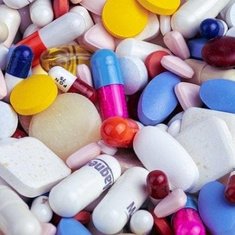|
what is toxicokinetics?
|
what is toxicodynamics?
|
|
interaction between the body & the substance - what does the body do to the substance?
|
interactions between a substance & its biological target - what does the substance do to the body?
|
|
what curve do we use to measure toxicodynamics?
|
|
dose-effect curve
|
|
what is the ED50?
|
what is the LD50?
|
what is the therapeutic index?
|
what is first-pass metabolism?
|
|
the dose of a substance that produces the desired effect in 50% of the population
|
the dose of a substance that is required to kill 50% of the population
|
the therapeutic window of safety of the substance (LD50/ED50)
|
the first pass of the substance through the liver, being metabolised by the hepatic enzymes
|
|
what is bioavailability?
|
how do you calculate bioavailability?
|
|
the fraction of a substance that reaches the systemic circulation (after first-pass metabolism)
|
AUC oral/AUC iv (area under the curve of the oral dose of drug/area under the curve of the intravenous dose of the drug) |
|
what is ADME?
|
what is the A in ADME?
|
|
absorption, distribution, metabolism, elimination
|
absorption: the process of the substance being taken up into the circulation
|
|
what is the D in ADME?
|
what are the 5 factors that affect this?
|
what is Vd?
|
how do we calculate Vd?
|
|
distribution: the transfer of the substance from the bloodstream to the tissues
|
blood flow
|
volume of distribution - the degree to which the substance is taken up by the tissues rather than staying in the blood
|
amount of drug in the body/concentration in the blood
|
|
vascular permeability
|
|
perfusion rate of the tissue
|
|
lipid solubility of the substance
|
|
ability of the substance to bind to plasma proteins
|
|
what is the M in ADME?
|
what is the goal of M?
|
what does this do to reabsorption?
|
|
metabolism: the conversion of the substance by enzymes into metabolites, which can either activate or deactivate the substance
|
to convert the substance into a more hydrophilic compound, which speeds up the rate of excretion by the kidneys
|
this reduces the reabsorption of the metabolite back into the renal tubules, as it is less lipid soluble
|
|
what is Phase I M?
|
what reactions are included in Phase I, and what enzyme does this normally involve?
|
what happens if the drug is sufficiently polar after Phase I?
|
what does Phase I do to the drug?
|
|
where the substance is converted to a more polar metabolite by adding or changing a functional group
|
oxidation
|
it may be eliminated without undergoing further metabolism
|
activates or deactivates the original substance
|
|
reduction
|
|
hydrolysis
|
|
cytochrome P450 enzyme system
|
|
what is Phase II M?
|
what does Phase II do?
|
what does this do to reabsorption?
|
what is Phase II catalysed by?
|
|
the metabolite is conjugated with a charged compound such as glutathione
|
increases the molecular weight
|
makes it less likely to be reabsorbed by the kidneys as it is bigger
|
a family of non-specific transferases that require endogenous co-factors in order for the reaction to proceed
|
|
increases the hydrophilicity
|
makes it more likely to be excreted by the kidneys as it is more water soluble
|
|
deactivates the substance if Phase I did not
|
-
|
|
what is Phase III M?
|
how are products of Phase II & III removed from the cell?
|
|
metabolites that could not be eliminated after Phase I & II are further processed, such as by acetylation
|
by various transporter proteins, which allows the products to now be eliminated
|
|
what is the E in ADME?
|
what are the mechanisms of E of the substance?
|
what are the 2 models of E?
|
what does the plasma concentration of each of these models do over time?
|
|
elimination: removal of the substance from the body by the kidneys, gut, lungs, or skin
|
urine
|
first-order elimination (the most common): the elimination rate of the substance is directly proportional to its concentration
|
decrease exponentially over time
|
|
feces
|
|
sweat
|
zero-order elimination: the elimination rate of the substance is independent of the concentration
|
decrease in a linear fashion over time
|
|
exhaled breath
|
|
breast milk
|

